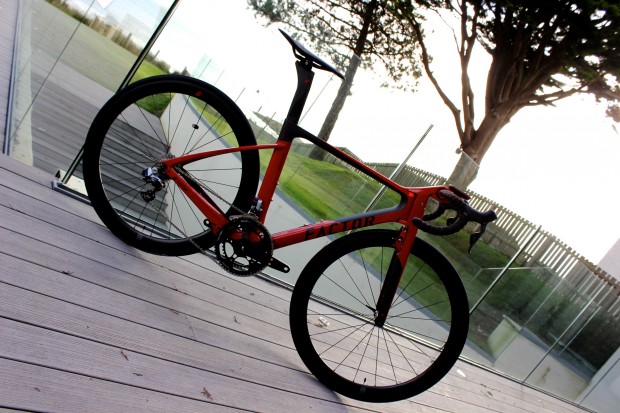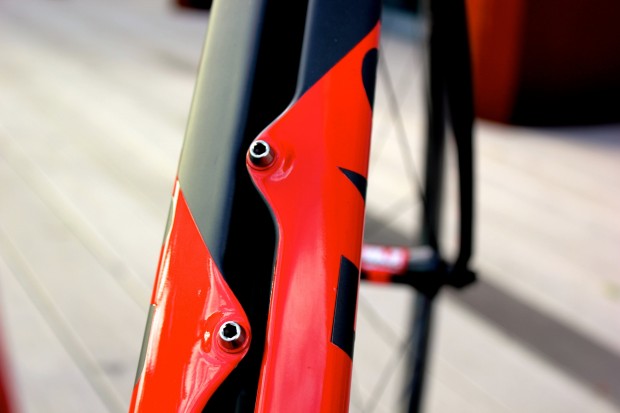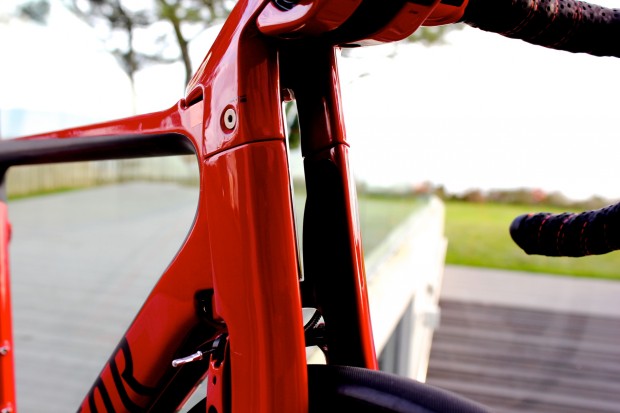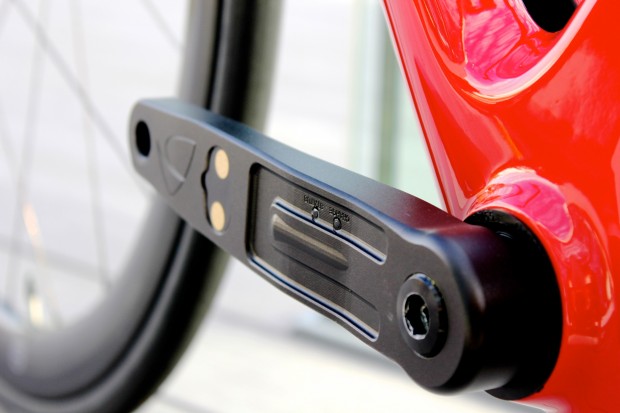How often do you see a bike that completely stops you in your tracks?
Familiarity breeds contempt, they say, and the curse of the bike journalist, surrounded on a daily basis by very nice bikes indeed, can be a dulling of the senses. Enter Factor Bikes’ Vis Vires, which, on first acquaintance, delivers the sort of visual jolt you might experience upon encountering a Formula One car in a supermarket car park.

The F1 analogy is apt. Factor’s parent company is bf1 systems, supplier of composite manufacture and measurement systems to the upper echelons of motor sport. Factor’s debut bicycle, the 001, a machine that showcased the company’s performance measurement systems, gained mixed reviews. The Vis Vires, however, is the result of a collaboration with Steve Domahidy, co-founder and former head of R&D at Niner Bikes, and intended to provide a ride quality to match its impressive engineering. Check back tomorrow for our Industry Insider profile.
It’s hard to know where to begin when analysing a machine with so many intriguing design solutions. What we can say even at this early stage in our acquaintance is that the Factor Vis Vres is a machine that rewards close inspection. The longer you look, the more of its subtleties become apparent. Where are the cables on this bike, for example? Let’s find out.
The chassis
The carbon frame features a host of intriguing designs, chief of which is the split downtube: a channel that begins at the junction with the headtube and continues to and through the bottom bracket shell, one that houses a 386 standard bottom bracket. The ‘dual downtube’ is one of several impressive engineering feats present on the Vis Vires and the result of comparative testing against a prototype with a conventional, solid downtube at a wind tunnel facility in Denver, Colorado. While slimmer downtubes offer greater aero efficiency, they lack the torsional rigidity of bulkier offerings. The channel in the sizable downtube of the Vis Vires is intended to offer the best of all worlds.
The toptube broadens from 30mm at the seattube to 50mm at its junction with the headtube, where it rises in a small lip to smooth the junction with the stem. It’s another aspect of the Vis Vires that appears to be subject to aero considerations, although with nothing as radical as channel; more a depression. Of greater interest, perhaps, is the integrated seatclamp, whose 4mm Allen bolt sits in front of the aero-formed seatpost.

The headtube is low (113mm on our 51cm test bike), rounded at its leading edge and relatively shallow in the side profile; while by no means slender, it doesn’t feature the excessive carbon real estate we’ve seen on some models. Much of the stiffness is likely to come from its bracing, top and bottom, by the fork and stem.
The seattube is flat-backed, in common with other aero bikes that employ the truncated airfoil profiles of Dr Kamm, and becomes sharper in the leading edge as it journeys towards its junction with the toptube. At the opposing end, the seattube broadens to a pyramid and the junction with the bottom bracket. There are voids in the leading edge and trailing edge to improve air flow.
BMC-style, shallow seatstays join the seattube some 90mm below its top, and are noticeably curved. Their most interesting aspect, however, is the vast clearance offered either side of the tyre, presumably to smooth airflow, removing turbulence and its inevitable consequence: drag.
The non-driveside chainstay, a simple spar on less sophisticated machines, is a sculpted affair on the Vis Vires, with a recess on its underside that shields the TRP TTV carbon v-brake behind the bottom bracket shell. Further along, you’ll find the housing for the speed sensor, another integrated feature that speaks volumes for the level of consideration in this machine.
The front end of the Vis Vires is the most visually stunning aspect of this visually stunning bike. The stem and the fork are two halves of one whole and joined with an internal rod. A clamp moulded to the trailing edge of the fork blades unites them, serving as a quasi crown, and attaching them the bottom of the steerer tube.

Viewed from the front, the paper-thin blades form a giant void around the wheel, not unlike the design employed by Wilier for its TwinFoil time trial bike, and which will presumably serve a similar purpose here: to allow air to flow unhindered around the leading edge of the bike. Interestingly, it’s the one area of the bike that prevented the Vis Vires from gaining the UCI’s seal of approval. The trailing edge of each fork leg has a recess at the top that provides a shielded home for an integrated TRP TTV carbon v-brake, mirroring the design of the chainstay.
The stem is another impressive design feat, serving a dual purpose as the top section of the fork and handlebar clamp. It’s split into two sections: the first connects to the fork and the headtube and clamps the handlebar from above, while a separate section clamps the handlebar from below and contains the cabling for the integrated Garmin Edge computer mount.
The stem’s sleek design has not come at the expense of function. A series of ‘hex wedges’ allow it to be adjusted through seven settings each for height and length. Our test bike is supplied in ‘position seven’, placing the centre of the handlebar 90mm in front of the steering axis and 34mm above the lower edge of the stem. There’s a range of adjustment of plus or minus 5mm in either axis, which would allow us to extend the ‘length’ our 90mm stem to 95mm, or reduce it to 85mm. Similarly, we could raise the handlebars to 39mm above the lower edge of the stem, or reduce it to 29mm. Factor ask customers for fit data if they have had a bike fit and supply the bike with a corresponding handlebar position.
The components
The Vis Vires is offered in three builds: Shimano Ultegra, Shimano Dura-Ace Di2, and the model we’re testing, Shimano Dura-Ace Di2 with Factor’s own Factor Power Measurement Crank, one equipped with strain gauges and telemetry in each arm that will send the rider’s power data via the ANT+ protocol to the integrated Garmin Edge 810 computer (or indeed to any ANT+ enabled device). Once the preserve of the professional cyclist, equipment to measure power output is becoming increasingly popular. Factor, however, claim greater sophistication for its crank: an ability to measure force throughout the pedal stroke, rather than taking samples at various points.

The crank supplied with our test bike (170mm for the 51cm frame; larger frame sizes come with longer cranks) is a prototype and samples power output internally at 96Hz before compressing the file to the 4Hz bandwidth on which ANT+ relies. Later this year, Factor plans to introduce internal sampling and data transfer at 192Hz to work in conjunction with a ‘logger box’, either connected to the bike or worn by the rider, to provide data on force, torque, and crank position, independently from either crank arm, for analysis in real time and post-ride.
Ours is fitted with Praxis Works cold-forged chainrings with a racy 53-39 ratio, which, combined with the Shimano Dura-Ace 11-25 cassette, perhaps provides a clue to Factor’s intentions for the bike. The remainder of the drivetrain components are from Shimano’s flagship Dura-Ace Di2 electronic groupset.
Wheels
The Vis Vires rolls on co-branded hoops from new wheel manufacturer, Black Inc. The wheels are full carbon clinchers, some 45mm deep, and exhibiting the much-admired rounded profile deployed by Bontrager, ENVE and others, intended to offer a superior performance in crosswinds to the high-sided designs that characterised what might be called first generation carbon wheels. They revolve on DT Swiss 240S hubs, laced with 20 radially laced, straight-pull, aero-bladed spokes up front and 24 of the same in a two-cross pattern on both sides of the rear. They’re shod with Vittoria Open Corsa CX111 tyres, boasting a 320TPI cotton casing that we hope will prove extremely supple.
Finishing kit
As befits a bike of this pedigree, not to mention price, the finishing kit is of the highest standard. The ENVE Composites carbon handlebar has been custom designed for the Vis Vires, and contains the brake and gear cables. Our 51cm test bike is supplied with a 40cm bar; larger frames come with wider bars. The saddle is Fizik’s flagship Arione 00; a £200 perch we tested earlier this year. It’s mounted on Factor’s own, aero-profiled carbon seatpost.
We’ll be testing the Factor Vis Vires in the weeks ahead. Check back soon for a full review, and check back tomorrow for our Industry Insider profile of designer, Steve Domahidy.
Price: £7,999; £9,999 with Factor Power Measurement Crank
Sizes: 51cm, 54cm, 56cm, 58cm, 61cm
Colour: Team Orange, Stealth
Website: Factor Bikes






